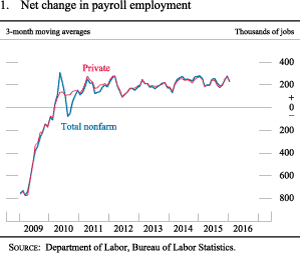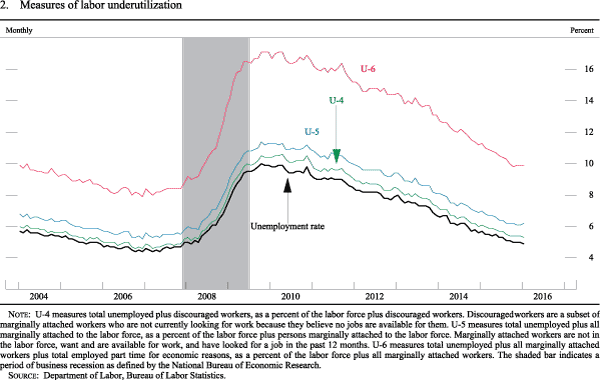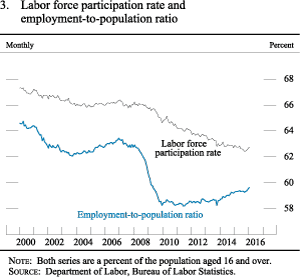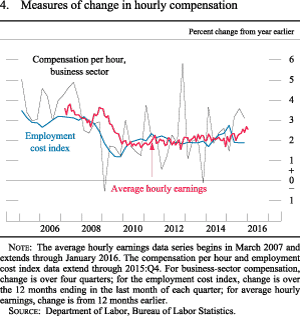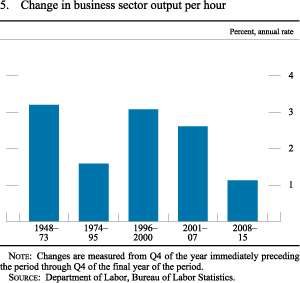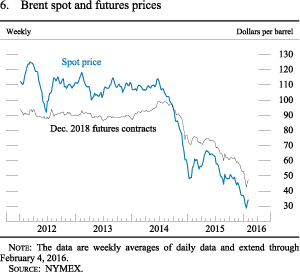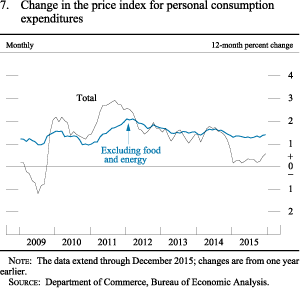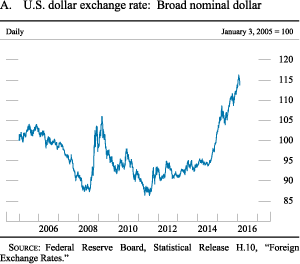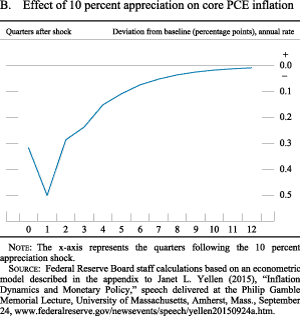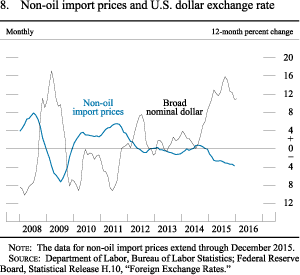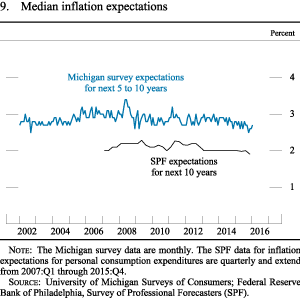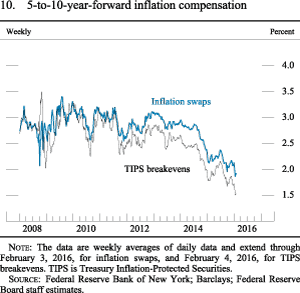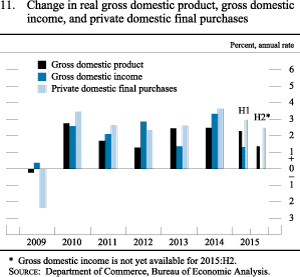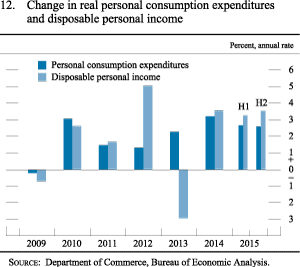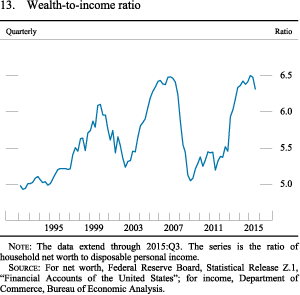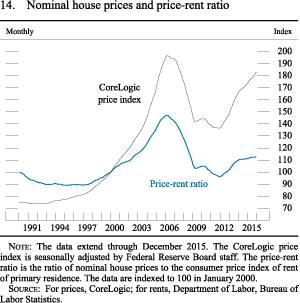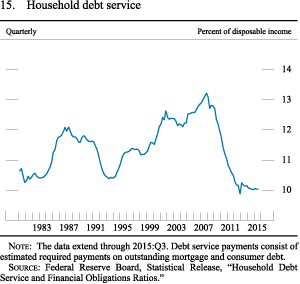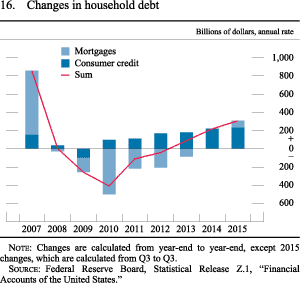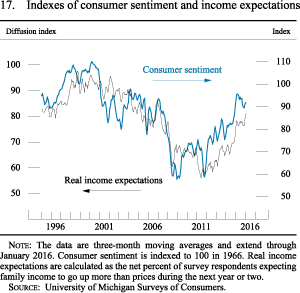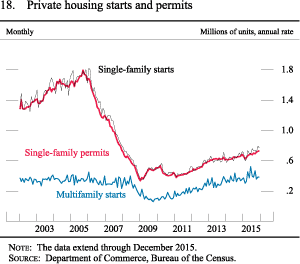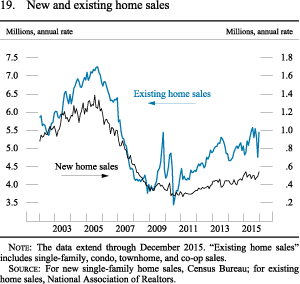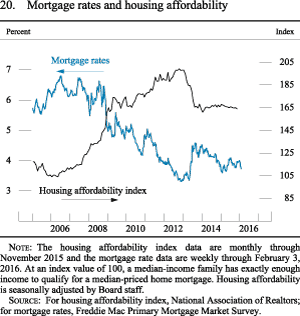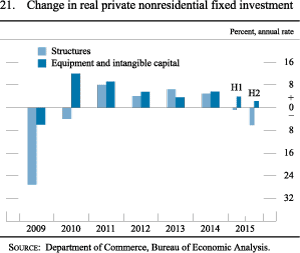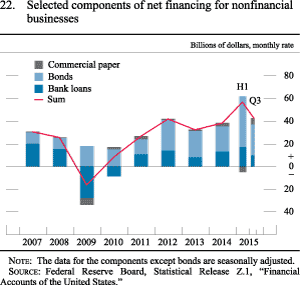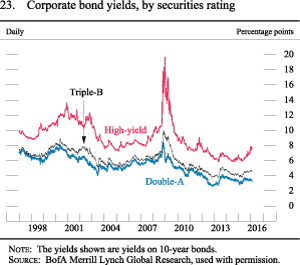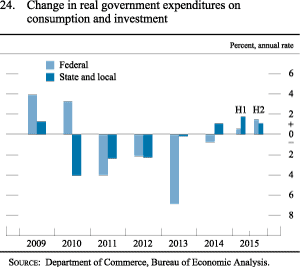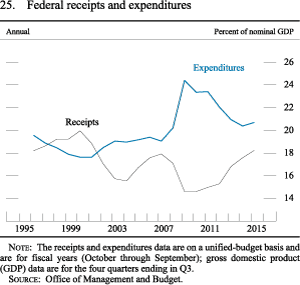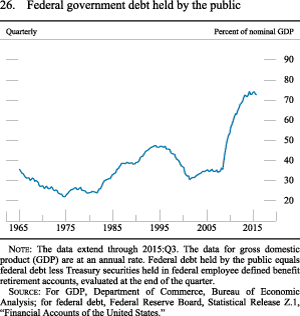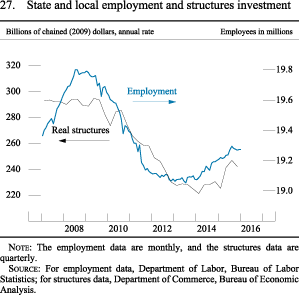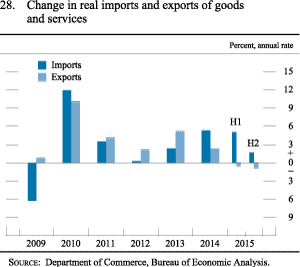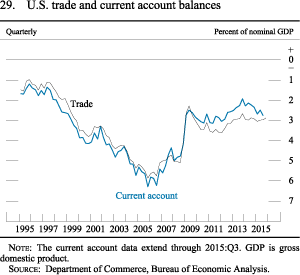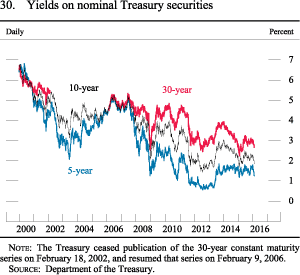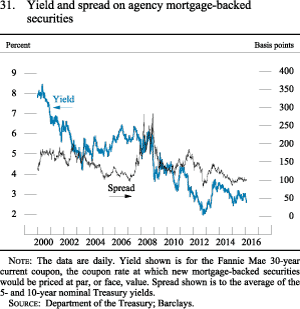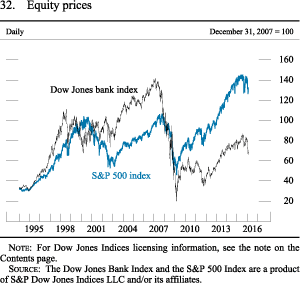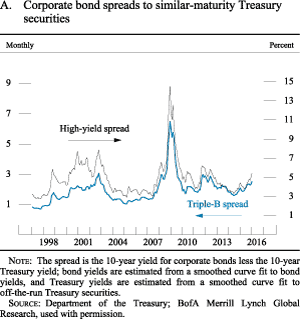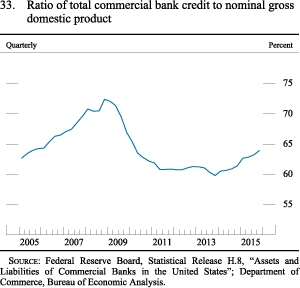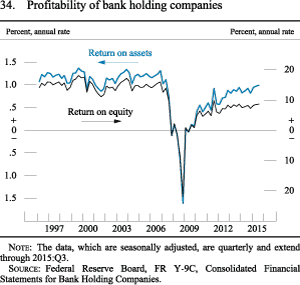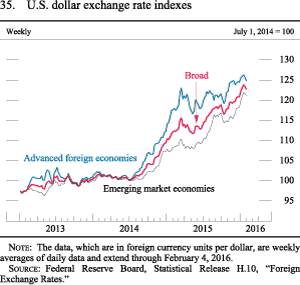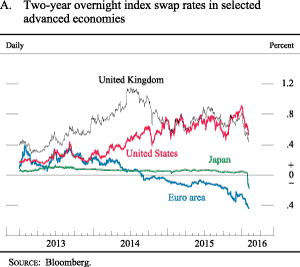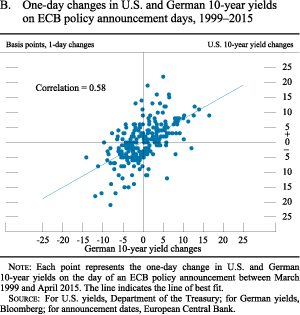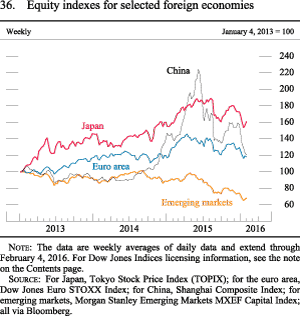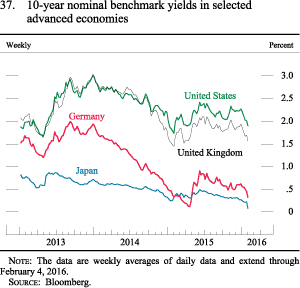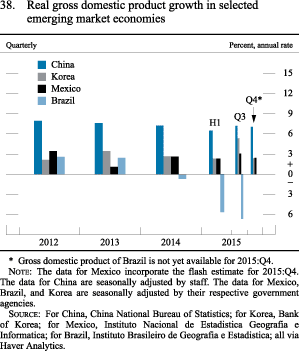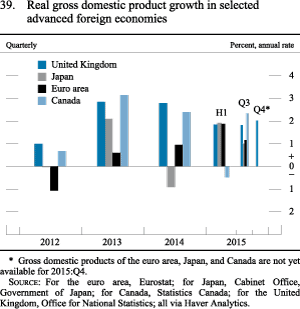- February 10, 2016: Summary
- Part 1
- Part 2
- Part 3
- Abbreviations
- Printable Version (1.2 MB PDF)

Sections of Part 1
Part 1: Recent Economic and Financial Developments
Monetary Policy Report submitted to the Congress on February 10, 2016, pursuant to section 2B of the Federal Reserve ActThe labor market continued to improve during the second half of last year and early this year. Payroll employment has increased 225,000 per month, on average, since June. The unemployment rate fell from 5.3 percent in June to 4.9 percent in January and thus has reached the median estimate among Federal Open Market Committee (FOMC) participants of the level of unemployment that is considered to be normal in the longer run. Even so, the relatively low labor force participation rate and the unusually large number of people working part time who would prefer full-time employment suggest that some cyclical weakness is still present in the labor market. Since mid-2014, a steep drop in crude oil prices has exerted significant downward pressure on overall inflation, and declines in the prices of non-oil imported goods have held down inflation as well. The price index for personal consumption expenditures (PCE) increased only 1/2 percent during the 12 months ending in December, a rate that is well below the FOMC's longer-run objective of 2 percent; the index excluding food and energy prices rose 1-1/2 percent over the same period. Both survey- and market-based measures of inflation expectations have moved down since June. Meanwhile, real gross domestic product (GDP) increased at an annual rate of 1-1/4 percent over the second half of 2015, slower than in the first half. The growth in GDP has been supported by accommodative monetary policy, favorable consumer confidence, and the boost to household purchasing power from lower oil prices. However, lower oil prices have also exerted downward pressure on domestic investment in the energy sector. In addition, sluggish growth abroad and the higher foreign exchange value of the dollar have weighed on exports, and financial conditions more generally have become somewhat less supportive of economic growth. Concerns about economic conditions abroad and the energy sector have contributed to lower equity prices and higher borrowing rates for some businesses.
Domestic Developments
The labor market has continued to improve...
Labor market conditions strengthened further across a variety of dimensions over the second half of 2015 and early this year. Payroll employment gains remained robust, averaging about 235,000 per month over the second half of last year, similar to the gains over the first half; factoring in the January increase of about 150,000, monthly gains since June have averaged about 225,000 (figure 1). The increase in 2015 followed an even faster pace of job gains in 2014, and, in total, some 5-3/4 million jobs were added over the two years. In addition, the unemployment rate--which had reached 10 percent in late 2009--declined from 5.3 percent in June 2015 to 4.9 percent in January of this year; this level is 3/4 percentage point lower than a year earlier and is equal to the median of FOMC participants' estimates of its longer-run normal level (figure 2). Broader measures of labor underutilization, such as those including individuals who are classified as marginally attached to the labor force, declined by similar amounts. (A "marginally attached" individual is defined as someone who is not looking for work currently and therefore treated as not in the labor force, but who wants and is available for work and has looked for a job in the past 12 months.)
...though some labor market slack likely remains...
While payroll employment and the unemployment rate have improved further since mid-2015, the labor force participation rate fell from an average of 62.7 percent of the working-age population during the second quarter of 2015 to 62.5 percent in the fourth quarter; the participation rate moved back up to 62.7 percent in January (figure 3). Changing demographics--most notably the increasing share of older people in the population, who are less likely to be in the labor force--and other longer-run structural changes in the labor market have continued to push down the participation rate even as cyclical forces have been pushing it up. That said, labor force participation appears to remain a little weaker than can be explained by structural factors alone, pointing to the likelihood that some slack remains in this dimension of labor utilization. In addition, although the share of workers who are employed part time but would like to work full time has fallen noticeably since June, it is still relatively high, indicating some scope for improvement on this dimension as well.
...while labor compensation has shown some tentative signs of accelerating...
As the labor market has continued to improve, the rates of increase in some measures of hourly labor compensation have begun to pick up while others remain relatively subdued. For example, average hourly earnings for all employees increased 2-1/2 percent over the 12 months ending in January, above the 2 percent pace seen throughout most of the recovery (figure 4). In addition, compensation per hour in the business sector--a volatile measure derived from the labor compensation data in the national income and product accounts, or NIPA--is reported to have increased more quickly in 2015 than its average pace throughout most of the recovery. In contrast, the employment cost index for private industry workers, which measures both wages and the cost to employers of providing benefits, increased about 2 percent over the 12 months ending in December, similar to the pace seen throughout most of the recovery. All of these measures of compensation are increasing at slower rates than those seen prior to the recession. This deceleration probably reflects a variety of factors, including the slower growth of productivity, the slower pace of inflation, and perhaps some remaining slack in the labor market. Despite the continued relatively small increases in nominal wages, the recent very low inflation led to a noticeably larger wage gain last year on a purchasing-power-adjusted (or so-called real) basis than had been evident earlier in the expansion.
...and productivity growth has been lackluster
Over time, increases in productivity are a key determinant of the rise in real wages and living standards. Labor productivity in the business sector increased at an annual rate of just 1/2 percent in 2015 and at an average annual rate of just 1 percent since the last business cycle peak in 2007 (figure 5). The average pace since 2007 is a little below the 1974-95 average and well below the pace during the period from the mid-1990s to 2007. The reasons behind the slower productivity performance in recent years are not well understood, but one factor seems to be the slower pace of capital accumulation.
Falling oil prices continue to hold down overall consumer prices...
Consumer price increases have remained muted and below the FOMC's longer-run objective of 2 percent. As discussed in the box "Effects of Movements in Oil Prices and the Dollar on Inflation," crude oil prices have plummeted since June 2014, and the dollar has moved appreciably higher; both factors have contributed importantly to the low inflation readings of the past year.
Since July, the price of crude oil has fallen appreciably further, on net, with the spot price of Brent crude oil dropping below $35 per barrel, a level last seen more than a decade ago (the blue line in figure 6). Futures prices have also dropped significantly and indicate that market participants expect only modest price increases over the next few years. Although concerns about global growth have contributed to the fall in prices, much of the recent decline can be attributed to the abundance of global supply. Reductions in U.S. production have been slower and smaller than expected, and OPEC has abandoned its official production target in favor of maintaining robust production despite declining prices and the likely increase in Iranian oil exports in the coming months. The drop in crude oil prices continues to pass through to gasoline prices: The national average of retail gasoline prices (on a seasonally adjusted basis) moved down from more than $2.50 per gallon in June to about $2.00 per gallon in January.
Largely because of the decline in energy prices, overall consumer price inflation, as measured by the PCE price index, was running at just 1/4 percent for the 12 months ending in June 2015; the 12-month change remained near that pace until year-end, when it edged up to 1/2 percent as some of the sharpest declines from a year earlier fell out of the 12-month calculation (figure 7).
Food prices were little changed over the past six months after edging down during the first half of 2015. Consumer food prices were held down in 2015 by falling food commodity prices, but futures markets suggest that these commodity prices will flatten out, implying that this source of downward pressure on consumer food price inflation is likely to wane.
Effects of Movements in Oil Prices and the Dollar on Inflation
Over the past year, inflation has continued to run well below the Federal Open Market Committee's longer-run objective of 2 percent (text figure 7). The 12-month change in the personal consumption expenditures (PCE) price index, which was about 1/2 percent in 2015, was held down most clearly by falling prices for oil and farm commodities. Falling prices for other commodities and the rise in the foreign exchange value of the dollar have also contributed importantly to continued low rates of inflation. Indeed, reflecting these influences, inflation for items other than food and energy remained relatively low, with core PCE price inflation at slightly under 1-1/2 percent last year.
Since the middle of 2014, crude oil prices have tumbled, with the spot price of the global benchmark Brent crude oil falling from over $115 per barrel to under $35 per barrel in recent weeks; prices for a wide variety of other commodities have also declined considerably. The pass-through of falling oil prices into lower gasoline prices is typically relatively rapid, and the drop in consumer energy prices held down overall PCE inflation directly by more than 1/2 percentage point in 2015. Falling farm commodity prices also reduced consumer food price inflation over the past year, although the pass-through of these commodity price changes into overall PCE inflation tends to be somewhat smaller and more gradual than with oil prices. Additionally, the sustained reduction in both oil and non-oil commodity prices has likely lowered core inflation somewhat by holding down firms' production and distribution costs. Empirical estimates of the pass-through of energy costs into core inflation are generally quite small, with long and variable lags. Nonetheless, even with a small degree of pass-through, the very large declines in energy prices since the middle of 2014 have likely been holding down core consumer price inflation somewhat.
The broad dollar has appreciated more than 20 percent since the middle of 2014, reflecting both heightened concerns about the global outlook, which have resulted in safe-haven flows toward dollar assets, and diverging expectations regarding domestic and foreign monetary policy (Figure A). A stronger dollar makes foreign goods cheaper for U.S. consumers. An extensive literature, however, has found that the pass-through of exchange rate changes to U.S. import prices is incomplete--that is, less than proportionate--as foreign exporters prefer to absorb part of the exchange rate change by narrowing profit margins. For example, a typical estimate is that a 10 percent appreciation of the dollar causes the prices of non-oil imported goods to decline about 3 percent after one year. 1 Roughly one-third of this effect occurs through the effect on imported commodities, as an increase in the value of the dollar tends to lower commodity prices proportionately.
Because imported goods and services make up only a modest share of U.S. consumption, a given percentage decline in import prices causes a much smaller percentage reduction in core PCE prices. Figure B uses a simple econometric model to illustrate how a 10 percent appreciation of the dollar might affect core PCE inflation through this channel. 2 According to this model, core PCE inflation dips in the two quarters following the appreciation before gradually returning to the baseline, leading to a four-quarter decline in core PCE inflation of about 1/4 percentage point relative to the baseline in the first year following the shock. Given the size of the dollar's appreciation since the middle of 2014, this model suggests that falling import prices depressed core PCE inflation about 1/2 percentage point last year. Although the exact magnitude of the dollar's effect on inflation depends on the specific model used, this exercise suggests that the stronger dollar has played a material role in holding down PCE inflation.
Although further declines in energy prices or a further rise in the exchange value of the dollar are certainly possible, those movements will eventually stop. As these prices stabilize, the drag on consumer price inflation from oil and import prices will dissipate. Moreover, with margins of resource utilization having already diminished appreciably and longer-run inflation expectations reasonably stable, both core and overall inflation are likely to rise gradually toward 2 percent over the medium term as these transitory factors fade and the labor market improves further.
Footnotes
1. For more detail, see Joseph Gruber, Andrew McCallum, and Robert J. Vigfusson (2016), "The Dollar in the U.S. International Transactions (USIT) Model," IFDP Notes (Washington: Board of Governors of the Federal Reserve System, February 8), www.federalreserve.gov/econresdata/notes/ifdp-notes/2016/the-dollar-in-the-us-international-transactions-model-20160208.html. Return to text
2. This model was discussed in a recent speech by Chair Yellen and is described in its appendix. See Janet L. Yellen (2015), "Inflation Dynamics and Monetary Policy," speech delivered at the Philip Gamble Memorial Lecture, University of Massachusetts, Amherst, Mass., September 24, www.federalreserve.gov/newsevents/speech/yellen20150924a.htm. Return to text
...but even outside of the energy and food categories, inflation has remained subdued
As is also discussed in the box "Effects of Movements in Oil Prices and the Dollar on Inflation," another important factor holding down inflation has been the behavior of import prices. After declining sharply in the first half of 2015, non-oil import prices continued to fall in the second half, albeit at a slightly more modest pace; the further declines in the second half reflected lower commodity prices as well as additional increases in the foreign exchange value of the dollar (figure 8). In addition, slack in labor and product markets likely placed downward pressure on inflation, although this factor has probably waned significantly. For all of these reasons, inflation for items other than food and energy (so-called core inflation) remained modest. Core PCE prices rose about 1-1/2 percent over the 12 months ending in December, similar to the increase in 2014.
Survey- and market-based measures of inflation expectations have moved down since June
Wage- and price-setting decisions are likely influenced by expectations for inflation. Survey measures of longer-term inflation expectations have been quite stable over the past 15 years but appear to have moved down some lately, including over the past 6 months, to the lower end of their historical ranges. This decline has occurred both for the measure of inflation expectations over the next 5 to 10 years as reported in the University of Michigan Surveys of Consumers and for the median expectation for the annual rate of increase in the PCE price index over the next 10 years from the Survey of Professional Forecasters, conducted by the Federal Reserve Bank of Philadelphia (figure 9). Market-based measures of medium- (5-year) and longer-term (5-to-10-year-ahead) inflation compensation derived from the difference between yields on nominal Treasury securities and Treasury Inflation-Protected Securities moved down further, on net, over the second half of the year after having declined notably between mid-2014 and mid-2015 (figure 10). Although changes in inflation compensation could reflect changes in expected inflation, they also may reflect a variety of other considerations, including an inflation risk premium, liquidity premiums, and other factors. 1
Economic activity expanded at a moderate pace in the second half of 2015
Real GDP is reported to have increased at an annual rate of 1-1/4 percent in the second half of last year, slower than the first-half pace (figure 11). As in the first half of the year, economic activity during the second half was supported by solid gains in private domestic final purchases--that is, final purchases by households and businesses--and by modest increases in government purchases of goods and services. By contrast, aggregate demand continued to be held down by weak export performance, reflecting the rise in the foreign exchange value of the dollar and sluggish foreign economic growth. In addition, inventory investment slowed markedly from its elevated first-half pace, thereby reducing overall GDP growth in the second half of 2015.
Gains in income and wealth are supporting consumer spending...
Real personal consumption expenditures rose at an annual rate of 2-1/2 percent in the second half of 2015, about the same as the first-half pace (figure 12). These increases have been supported by income gains from the improving labor market as well as the fall in gasoline and other energy prices, which has bolstered consumers' purchasing power. As a result, real disposable income--that is, income after taxes and adjusted for price changes--rose a robust 3-1/2 percent in 2015 after a similar gain in 2014.
Consumer spending last year was also likely supported by further increases in household net worth. Although the value of corporate equities edged down last year, prices of houses--which are owned much more widely than are corporate equities--posted significant gains, and the wealth-to-income ratio remained elevated relative to its historical average (figure 13). In nominal terms, national house price indexes are now close to their peaks of the mid-2000s, but relative to rents, house price valuations are much lower than a decade ago (figure 14).
Coupled with low interest rates, the rise in incomes has lowered debt payment burdens for many households. The household debt service burden--the ratio of required principal and interest payments on outstanding household debt to disposable income, measured for the household sector as a whole--has remained at a very low level by historical standards (figure 15). As interest rates rise, the debt burden will move up only gradually, as most household debt is in fixed-interest products.
...as is credit availability
Consumer credit continued to expand moderately through late 2015, as lending standards for both auto lending and student loans remained accommodative (figure 16). In addition, credit card lending has been rebounding since early last year. Standards and terms on credit cards are still relatively tight for riskier borrowers, although there has been some modest increase in access for borrowers with subprime credit histories. Delinquencies on credit card and auto loans are still near historical lows, in part due to the tight standards.
Consumer confidence remains high
Household spending has also been supported by favorable consumer sentiment. For the past year or so, the overall index of consumer sentiment from the University of Michigan Surveys of Consumers has registered levels comparable to those that prevailed before the recession (figure 17). Rising real incomes, partly driven by falling energy prices and improvements in the labor market, have likely driven up consumer confidence. These same factors are probably behind the more upbeat expectations that households report for real income changes over the next year or two, which are now near pre-recession levels.
Residential construction has improved modestly
The gradual recovery in residential construction activity continued over the second half of last year. Both single- and multifamily housing starts registered moderate increases in 2015 (figure 18). Sales of new and existing homes also rose moderately, abstracting from the temporary plunge in existing home sales in November, which reportedly reflected a lengthening in closing times due to new mortgage disclosure rules (figure 19). But while multifamily starts have recovered to their pre-recession level, single-family construction continues to be well below its earlier pace. The level of housing starts is still being held down by a meager pace of household formation, tighter-than-average mortgage credit supply, and shortages of skilled labor and other inputs in the construction sector.
Although the October 2015 and January 2016 Senior Loan Officer Opinion Survey on Bank Lending Practices (SLOOS) reports suggest that a gradual easing of bank lending standards has continued over the past six months, mortgage credit is still difficult to access for borrowers with low credit scores, undocumented income, or high debt-to-income ratios. 2 For borrowers who can obtain credit, interest rates on mortgages remain near their historical lows, although they inched up, on net, over the second half of the year (figure 20). In 2015, outstanding mortgage debt rose for the first time since the recession as mortgage originations for home purchases increased and write-downs of mortgage debt continued to ebb.
Overall business investment has slowed as a result of a sharp drop in investment in the energy sector
Business investment (private nonresidential fixed investment) rose at an annual rate of only 1/2 percent during the second half of 2015 after increasing at a 3 percent pace during the first half of the year (figure 21). Spending on equipment rose modestly, and a bit faster than during the first half of 2015, but spending on intangibles, such as research and development, and investment in structures outside of drilling and mining flattened out after posting strong gains during the first half of the year. Investment in structures used in the energy sector continued to fall precipitously, as the drop in oil prices has scuttled investment in higher-cost oil and gas wells. For the year as a whole, the pace of overall business investment slowed compared with 2014, mostly as a result of the drop in the energy sector. Investment has been supported by low interest rates and financing conditions that are still generally accommodative, though somewhat less so than earlier.
Corporate financing conditions have become somewhat less supportive
Domestic financial conditions for nonfinancial firms have become somewhat less supportive of growth since last June, particularly for non-investment-grade firms. Equity prices have declined and bond spreads have widened amid concerns about the global economic outlook and oil prices. Downgrades of bonds issued by nonfinancial companies have increased, and the leverage of these companies is near the top end of its range over the past few decades. Nonetheless, profitability has remained high outside the energy sector. Against a backdrop of low interest rates, investment-grade nonfinancial businesses have continued to raise substantial amounts of funds in bond and loan markets since last June, in part to finance mergers and acquisitions activity (figure 22). Speculative-grade bond issuance also was solid for much of 2015 but diminished toward the end of the year as spreads widened notably, particularly for firms in the energy sector (figure 23).
Loan demand remained strong across most major categories through the end of 2015. Of note, demand for commercial real estate (CRE) loans strengthened further and issuance of commercial mortgage-backed securities (CMBS) remained robust. Credit conditions tightened for this sector as concerns about credit quality led to wider spreads on CMBS and, according to the results of the October and January SLOOS reports, a moderate number of banks had tightened lending standards for CRE loans, particularly for construction and land development. A modest fraction of banks also reported having tightened lending standards for commercial and industrial loans to firms of all sizes since the second quarter.
The drag from federal fiscal policy has ended...
After being a drag on aggregate demand during much of the expansion, federal fiscal policy has shifted to a more neutral stance as fiscal consolidation efforts have abated. During 2015, policy actions had little effect on taxes and transfers, and real federal purchases of goods and services edged up (figure 24).
The federal budget deficit narrowed further in fiscal year 2015 to 2-1/2 percent of GDP, largely reflecting the increase in tax receipts owing to the ongoing economic expansion as well as the modest increase in purchases (figure 25). A deficit of this size is small enough to stabilize the ratio of the debt held by the public to nominal GDP; that said, the current level of that ratio is elevated relative to its average over the post-World War II period (figure 26). The Congressional Budget Office projects the deficit to move up to about 3 percent of GDP in fiscal 2016.
...and state and local government expenditures are rising moderately
Fiscal conditions of most state and local governments continue to improve gradually. Tax revenues have been rising moderately, supported by the expansion of economic activity and increasing house prices. These governments boosted spending at a moderate rate in 2015. In particular, real state and local purchases of goods and services rose 1-1/2 percent last year, as employment posted another modest gain and real construction spending rose markedly for the first time since the recession (figure 27).
In contrast, net exports still held down growth in gross domestic product slightly
Exports held about flat in the second half of 2015, weighed down by the appreciation of the dollar and by soft foreign economic growth (figure 28). Although the stronger dollar made imports more affordable, import growth was also relatively subdued. Imports for inputs related to oil exploration and production were particularly weak, consistent with steep declines in that industry. In all, real net trade continued to be a drag on real GDP growth in the second half of 2015. Although the real trade balance deteriorated, the nominal trade balance was little changed in 2015 in part because the value of imports declined, largely because of the decline in oil prices. Still, the current account deficit widened a bit to near 3 percent of nominal GDP as U.S. net investment income declined (figure 29).
Financial Developments
The expected path for the federal funds rate over the next several years declined
Despite further strengthening in labor market conditions and a range of other indicators that market participants viewed as consistent with continued expansion in the U.S. economy, market-based measures of the expected path of the federal funds rate over the next several years have moved down, on balance, since the middle of last year. Contributing to this shift were concerns about the foreign economic outlook and global disinflationary pressures, as well as Federal Reserve communications anticipating that economic conditions will warrant only gradual increases in the federal funds rate. Survey-based measures of the expected path of policy also moved down. According to the results of the most recent Survey of Primary Dealers, conducted by the Federal Reserve Bank of New York just prior to the January FOMC meeting, respondents' expectations for the federal funds rate target at the end of this year and next year were lower than those reported last June. Market-based measures of uncertainty about the policy rate approximately one to two years ahead declined, on balance, from their mid-2015 levels.
Longer-term Treasury yields decreased
Yields on longer-term nominal Treasury securities have declined since the middle of last year on net (figure 30). The decreases in nominal yields largely reflected reductions in inflation compensation; yields on long-term inflation-protected Treasury securities were little changed. Participants in the U.S. Treasury market reportedly were particularly attentive to developments abroad, especially turbulence in Chinese financial markets, and to fluctuations in oil prices. Consistent with the changes in yields on Treasury securities, yields on 30-year agency mortgage-backed securities (MBS)--an important determinant of mortgage interest rates--decreased, on balance, over the second half of 2015 and early 2016 (figure 31).
Broad equity price indexes decreased...
Since the middle of last year, amid considerable volatility, broad measures of U.S. equity prices have decreased notably, on net, as concerns about the foreign economic outlook appeared to weigh on risk sentiment and the outlook for corporate earnings growth (figure 32). Stock prices for companies in the energy and basic materials sectors dropped sharply, reflecting the continued fall in oil and other commodity prices. Implied volatility for the overall S&P 500 index, as calculated from options prices, increased, on balance, since the middle of last year; at times, its movement was notable.
...and risk spreads on speculative-grade corporate bonds moved up substantially, particularly for firms in the energy sector
Credit spreads in the corporate sector have widened across the credit spectrum. The spread of yields on investment-grade corporate bonds to yields on Treasury securities of comparable maturity rose moderately, and credit spreads on speculative-grade bonds widened substantially. Spreads for firms in the energy sector increased particularly sharply, reflecting the further drops in the price of oil since late June. Mutual funds investing in speculative-grade bonds experienced significant outflows over the second half of 2015 and early 2016, and, in December, redemptions from one such fund were suspended. During the second half of last year, the respondents to the Senior Credit Officer Opinion Survey on Dealer Financing Terms reported a moderate deterioration in liquidity and market functioning in speculative-grade corporate bonds and some tightening of the terms under which dealers were willing to provide financing to clients against such bonds.3 In addition, some metrics of corporate bond market liquidity suggest a slight deterioration over the second half of 2015 and early 2016, though most indicators remain at levels comparable with those seen prior to the crisis. For further discussion of corporate bond markets and other financial stability issues, see the box "Developments Related to Financial Stability."
Developments Related to Financial Stability
Financial vulnerabilities in the U.S. financial system overall have continued to be moderate since mid-2015. Regulatory capital and liquidity ratios at large banking firms are at historically high levels, and the use of short-term wholesale funding remains relatively low. Debt growth in the household sector continues to be modest and concentrated among borrowers with strong credit histories. Some areas where valuation pressures were a concern have cooled recently; in particular, risk premiums for below-investment-grade debt have widened. However, high leverage of nonfinancial corporations makes some firms highly vulnerable to adverse developments, such as lower oil prices or slowing global growth.
Vulnerabilities owing to leverage and maturity transformation in the financial sector remain low. Regulatory capital ratios at U.S. banking firms increased further in the third quarter of 2015, and holdings of high-quality liquid assets at banking firms also remain at very high levels. In addition, some of the largest domestic banks have reduced their reliance on potentially less stable types of short-term funding. The aggregate delinquency rate on bank loans declined to its lowest level since 2006, though delinquency rates on loans to the oil and gas industry, which account for a small share of most banks' portfolios, have increased. Bank underwriting practices in the leveraged loan market have improved, on balance, over the past year but occasionally still fall short of supervisory expectations. Moreover, domestic banking firms have only limited exposure to emerging market economies. However, developments in foreign economies and financial markets, particularly an escalation of recent volatility or a worsening of the outlook for China, could transmit risks through indirect financial linkages.
Net secured borrowing by dealers, primarily used to finance their own portfolios of securities, continued to decrease and is near historical lows, while securities financing activities aimed at facilitating clients' transactions also remain at low levels. The latter is consistent with reports that dealers have tightened price terms for securities financing and derivatives. The volume of margin loans outstanding--an important component of overall leverage used by hedge funds--appears to have moderated. Short-term funding levels remain relatively low, though reforms aimed at reducing structural vulnerabilities in those markets are still being implemented.
Overall asset valuation pressures have eased. Corporate bond spreads increased notably and are now above their historical norms (figure A). Those spreads appear to have risen by more than the compensation required for higher expected losses, suggesting risk premiums have also increased. Issuance of speculative-grade bonds and leveraged loans has slowed significantly, which also could reflect, in part, an increase in investors' risk aversion. Despite the volatility, most indicators of liquidity conditions in corporate bond markets, such as trading volumes and bid-asked spreads, deteriorated only slightly. Nonetheless, the suspension of redemptions in December by a high-yield bond mutual fund that had a high concentration of very low-rated debt and had experienced persistent outflows highlighted a vulnerability at open-end mutual funds that offer daily redemptions to investors while holding less-liquid assets.
Commercial real estate prices continued to rise, supported in part by improved fundamentals, and commercial real estate lending by banks accelerated in recent quarters. However, spreads on securities backed by commercial mortgages widened further and bank lending standards reportedly have tightened since July, suggesting that financing conditions have become a little less accommodative. In addition, late last year, federal banking regulators issued a joint statement reinforcing existing guidance for prudent risk management in that sector.1 Residential home prices also continued to increase. However, price-to-rent ratios do not suggest that valuations are notably above historical norms, and residential mortgage debt growth remains minimal.
Broad equity indexes have declined significantly since July 2015, and forward price-to-earnings ratios have fallen to a level closer to their averages of the past three decades. Yields on longer-term Treasury securities decreased over that period, and estimates of term premiums remained low. Because many assets are priced based on Treasury yields, their low level continues to pose a risk to valuations of assets that have lower-than-average earnings yields. However, in December, the Federal Reserve's increase in the target range for the federal funds rate did not result in significant changes in longer-term interest rates or their volatility.
The ratio of private nonfinancial sector credit to gross domestic product remains below estimates of its long-term upward trend, reflecting subdued levels of household debt. Debt growth in the nonfinancial business sector has slowed in recent months, particularly among speculative-grade and unrated firms. However, leverage of such firms has risen to historical highs, especially among those in the oil industry, a development that points to somewhat elevated risks of distress for some business borrowers.
As part of its effort to improve the resilience of financial institutions and overall financial stability, the Federal Reserve Board has taken several further regulatory steps. First, the Board finalized a rule that increases risk-based capital requirements for U.S. global systemically important bank holding companies (G-SIBs).2 The applicable surcharges are calibrated based on the systemic footprint of each U.S. G-SIB so that the amount of additional capital a firm must hold increases with the costs that its failure would impose in terms of U.S. financial stability. The G-SIB surcharge rule is designed to ensure that U.S. G-SIBs either hold substantially more capital, reducing the likelihood that they will fail, or choose to shrink their systemic footprint, reducing the harm that their failure would do to the financial system.
Second, the Board announced that it is seeking public comment on its proposed framework for setting the Countercyclical Capital Buffer (CCyB) and voted to affirm the CCyB amount at the current level of 0 percent--consistent with the continued moderate level of financial vulnerabilities.3 The buffer is a macroprudential tool that can be used to increase the resilience of the financial system by raising capital requirements on internationally active banking organizations when there is an elevated risk of above-normal losses in the future. The CCyB would then be available to help those banking organizations absorb shocks associated with worsening credit conditions, and it may also help moderate fluctuations in the supply of credit. In releasing the framework for comment, the Board consulted with the Federal Deposit Insurance Corporation and the Office of the Comptroller of the Currency. Should the Board decide to increase the CCyB amount in the future, banking organizations would have 12 months before the change became effective, unless the Board established an earlier effective date.
Third, the Board issued for public comment a proposed rule that would impose total loss-absorbing capacity and long-term debt requirements on U.S. G-SIBs and on the U.S. operations of certain foreign G-SIBs.4 The proposal would require each covered firm to maintain a minimum amount of unsecured long-term debt that could be converted into equity in a resolution of the firm, thereby recapitalizing the firm without putting public money at risk. The proposal would diminish the threat that a G-SIB's failure would pose to financial stability and is an important step in addressing the perception that certain institutions are "too big to fail."
Finally, the Board, acting in conjunction with other federal regulatory agencies, issued a final rule imposing minimum margin requirements on certain derivatives transactions that are not centrally cleared.5 The swap margin rule will reduce the risk that derivatives transactions would act as a channel for financial contagion and, by imposing higher margin requirements on uncleared swaps than apply to cleared swaps, will incentivize market participants to shift derivatives activity to central clearinghouses.
Footnotes
1. See Board of Governors of the Federal Reserve System, Federal Deposit Insurance Corporation, and Office of the Comptroller of the Currency (2015), "Agencies Issue Statement on Prudent Risk Management for Commercial Real Estate Lending," press release, December 18, www.federalreserve.gov/newsevents/press/bcreg/20151218a.htm. Return to text
2. See Board of Governors of the Federal Reserve System (2015), "Federal Reserve Board Approves Final Rule Requiring the Largest, Most Systemically Important U.S. Bank Holding Companies to Further Strengthen Their Capital Positions," press release, July 20, www.federalreserve.gov/newsevents/press/bcreg/20150720a.htm. Return to text
3. See Board of Governors of the Federal Reserve System (2015), "Federal Reserve Board Seeks Public Comment on Proposed Policy Statement Detailing the Framework the Board Would Follow in Setting the Countercyclical Capital Buffer (CCyB)," press release, December 21, www.federalreserve.gov/newsevents/press/bcreg/20151221b.htm. Return to text
4. See Board of Governors of the Federal Reserve System (2015), "Federal Reserve Board Proposes New Rule to Strengthen the Ability of Largest Domestic and Foreign Banks Operating in the United States to Be Resolved without Extraordinary Government Support or Taxpayer Assistance," press release, October 30, www.federalreserve.gov/newsevents/press/bcreg/20151030a.htm. Return to text
5. See Board of Governors of the Federal Reserve System, Federal Deposit Insurance Corporation, Office of the Comptroller of the Currency, Farm Credit Administration, and Federal Housing Finance Agency (2015), "Agencies Finalize Swap Margin Rule," joint press release, October 30, www.federalreserve.gov/newsevents/press/bcreg/20151030b.htm. Return to text
Short-term funding markets continued to function well
Short-term dollar funding markets have functioned smoothly during the second half of 2015 and early 2016. Markets for unsecured offshore dollar funding and repurchase agreements, or repos, generally did not exhibit signs of stress. Year-end funding pressures were modest.
Money market participants continued to focus on the Federal Reserve's use of its monetary policy tools. These tools proved effective in raising the federal funds rate following the FOMC's decision to increase the target range in December, while other money market rates also moved up broadly in line with the increase in the federal funds target range. For a detailed discussion, see the box "Monetary Policy Implementation following the December 2015 FOMC Meeting" in Part 2.
Treasury market functioning and liquidity conditions in the mortgage-backed securities market were generally stable
Indicators of Treasury market functioning have remained broadly stable over the second half of 2015 and early 2016. A variety of liquidity metrics--including bid-asked spreads and bid sizes--have displayed no notable signs of liquidity pressures over the same period. In addition, Treasury auctions generally continued to be well received by investors.
Liquidity conditions in the agency MBS market were also generally stable. Dollar-roll-implied financing rates for production coupon MBS--an indicator of the scarcity of agency MBS for settlement--suggested limited settlement pressures over the second half of 2015 and early 2016.
Bank credit has continued to expand and bank profitability rose further
Aggregate credit provided by commercial banks increased at a solid pace in the second half of 2015 (figure 33). The expansion in bank credit was mainly driven by strong growth in loans coupled with an increase in banks' holdings of agency MBS. The growth of loans on banks' books was generally consistent with the SLOOS reports of increased loan demand for many loan categories.
Measures of bank profitability remained below their historical averages but improved slightly during the third quarter of 2015 (the latest available data), supported by lower noninterest expenses (figure 34). Net interest margins were about unchanged, on average, during the third quarter. Delinquency and charge-off rates for most major loan types were generally stable, near or at their lowest levels since the financial crisis.
Among large bank holding companies (BHCs), despite generally positive third- and fourth-quarter earnings reports, equity prices have decreased markedly, on balance, since the middle of last year. The decline in bank equity prices likely reflected concerns about global growth, the effects of a flatter yield curve on the outlook for bank profitability, and potential losses due to the decrease in energy prices. Credit default swap (CDS) spreads for large BHCs increased on net.
The M2 measure of the money stock has increased at an average annualized rate of about 6 percent since last June, about the same pace registered in the first half of 2015 and faster than nominal GDP growth. Demand for liquid deposits has continued to boost M2 growth.
Municipal bond markets functioned smoothly, but some issuers remained strained
The M2 measure of the money stock has increased at an average annualized rate of about 6 percent since last June, about the same pace registered in the first half of 2015 and faster than nominal GDP growth. Demand for liquid deposits has continued to boost M2 growth.
Credit conditions in municipal bond markets have generally remained stable since the middle of last year. Over that period, the MCDX--an index of CDS spreads for a broad portfolio of municipal bonds--and ratios of yields on 20-year general obligation municipal bonds to those on longer-term Treasury securities edged up on net.
Nevertheless, significant financial strains were still evident for some issuers. In particular, Puerto Rico, which continued to face challenges from subdued economic performance, severe indebtedness, and other fiscal pressures, defaulted on some bond issues not backed by guarantees from the commonwealth and is seeking to restructure its debt.
International Developments
The dollar continued to strengthen...
The foreign exchange value of the dollar rose further, on net, since the middle of last year, bringing its increase since mid-2014, when the most recent run-up began, to over 20 percent by the beginning of 2016 (figure 35). Expectations that the Federal Reserve would soon start increasing its policy interest rates, even while most foreign central banks maintained or expanded monetary policy accommodation, boosted the value of the dollar. (For more discussion, see the box "Monetary Policy Divergence in the Advanced Economies.") The dollar has also appreciated against the renminbi since last summer, when the People's Bank of China (PBOC) announced it was changing its policy to allow market forces to play a greater role in determining the renminbi's exchange rate. The PBOC allowed the renminbi to depreciate 3 percent against the dollar in August and another 1-1/2 percent after the turn of the year. These developments, which contributed to intensified uncertainty about China's exchange rate policy and the prospects for its economy, fostered episodes of global market turbulence that further boosted the dollar. Investors became more focused on downside risks to prospects for growth in China and, by implication, global growth. These concerns about growth, along with still-strong oil production and high inventories, contributed to a sharp drop in commodity prices, which in turn weighed on the currencies of several commodity-exporting countries.
Monetary Policy Divergence in the Advanced Economies
As recovery has gradually taken hold in the U.S. economy over the past few years, both activity and inflation in the advanced foreign economies (AFEs) have remained persistently weak. This divergence in the economic outlooks for the United States and the AFEs has led to expectations of divergence in their monetary policies. Although the Federal Reserve raised its target for the federal funds rate in December, policy rates in most AFEs are near zero (and negative for several economies) and are expected to remain low for several years. Furthermore, the European Central Bank (ECB) and Bank of Japan are providing further monetary accommodation through sizable asset purchase programs, and both of these central banks have indicated that asset purchases will continue, given that inflation remains well below target. Given this ongoing monetary easing, the average policy rate expected by market participants over the next 24 months has declined in the euro area and Japan since 2014, while that of the federal funds rate gradually increased over this period as "liftoff" approached (figure A).
Two effects of these policy divergences that operate through financial markets have important consequences for the economies involved.1 First, and most obviously, monetary policy divergences have given rise to changes in exchange rates: Portfolio rebalancing by international investors toward economies and currencies with higher interest rates has put downward pressure on AFE currencies, and the dollar has appreciated significantly against these currencies since mid-2014 (text figure 35). This dollar appreciation has contributed to the drag that U.S. net exports have exerted on U.S. economic growth in recent quarters, but the stronger dollar also has contributed to cyclical stabilization abroad as expenditures have shifted toward weaker economies. This effect on international trade is also a consideration for U.S. and foreign monetary policies: All else being equal, a smaller contribution to the U.S. economy from the external sector likely points to a more gradual pace of policy normalization in the United States. By the same token, the economic stimulus from more-depreciated currencies abroad may allow AFE central banks to provide less monetary accommodation--or to start removing it earlier--than would otherwise be the case.
Second, the effect of monetary policy actions on financial conditions may spill over to interest rates in other countries. For example, on ECB policy announcement days, changes in U.S. and German long-term sovereign yields historically have been highly correlated (figure B); similarly large correlations are observed between U.S. and German yields on days when the Federal Reserve has made policy announcements. In the context of economic and policy divergences, these monetary policy spillovers may alter financial conditions in other countries in ways that are not necessarily consistent with their cyclical stabilization needs. For example, recent monetary easing abroad likely has had a tempering effect on longer-term U.S. interest rates that partially offsets the effect of our own policy normalization. Analogously, reduced monetary accommodation in the United States likely will partially offset the effect of greater monetary accommodation abroad. However, the implications of current policy divergences for monetary spillovers should not be exaggerated: U.S. policy remains accommodative and, on net, likely continues to contribute to accommodative conditions abroad.
Footnotes
1. For more detail, see John Ammer, Michiel De Pooter, Christopher Erceg, and Steven Kamin (2016), "International Spillovers of Monetary Policy," IFDP Notes (Washington: Board of Governors of the Federal Reserve System, February 8), www.federalreserve.gov/econresdata/notes/ifdp-notes/2016/international-spillovers-of-monetary-policy-20160208.html. Return to text
...while equity prices and foreign sovereign bond yields have declined
Triggered in part by the unexpected devaluation of the renminbi and an ensuing increase in concerns about global economic growth, equity indexes have dropped, on net, in most emerging market economies (EMEs) and advanced foreign economies (AFEs) since the beginning of the summer (figure 36). In particular, Chinese stock prices tumbled more than 40 percent despite official interventions, including circuit breakers and bans on stock sales, that were intended to mute some of the downward pressure. The fall in Brazilian stock prices was also very sharp, as global market turbulence as well as domestic developments, including a corruption scandal, declining output, and persistent high inflation, prompted stock prices to fall nearly 25 percent since last summer.
As in the United States, 10-year sovereign yields declined in most AFEs, likely in part because of increasing concerns about potential deflationary pressure amid falling commodity prices (figure 37). In the euro area, Greek sovereign yields, which had risen sharply in the first half of the year, declined substantially as an agreement was reached last summer between the European Union and Greece. In contrast, bond spreads in a number of EMEs rose modestly, on net, in the second half of the year before moving up more steeply after the start of 2016 amid a widespread increase in risk aversion.
Growth in the emerging market economies moved back up from earlier in 2015...
Following weak growth in the first half of 2015, economic activity in the EMEs improved in the second half, as the pace of growth picked up in Asia and Latin America (figure 38). However, growth has been held back in part by exports from EMEs, which declined appreciably early in 2015 and remain subdued on average.
Economic activity in most of emerging Asia, which had been restrained in the first half of the year by soft external demand and by the outbreak of MERS (Middle East Respiratory Syndrome) in South Korea, picked up in the second half, as the drag from these pressures subsided. In China, GDP growth is reported to have held steady around 7 percent in the second half of the year, boosted in part by relatively strong growth in services. However, weak manufacturing, as well as the financial market volatility noted previously, led to a pronounced heightening of concerns about the economy during the second half of the year.
In Latin America, the decline in commodity prices, along with other macroeconomic challenges, continued to weigh on the economic activity of several countries. In Mexico, the economy continued to grow at a moderate pace in the second half of 2015, supported by improving household demand. However, low oil prices have pressured public finances, and manufacturing exports faltered toward the end of the year. In Brazil, the economy is undergoing its most severe recession in decades. Tight monetary policy in response to high inflation, low commodity prices, and the fallout from a high-profile corruption scandal eroded business confidence and contributed to a collapse in investment.
Inflation remained subdued in many EMEs, as the continuing decline in commodity prices contributed to a moderation of headline inflation. Consequently, some central banks, including those of Korea and India, loosened monetary policy to support growth. In China, the PBOC also lowered its benchmark rate and cut the reserve requirement ratio in August and October to address weakness in the economy. In contrast, faced with inflationary pressures stemming partly from their depreciating currencies, Brazil, Chile, and Colombia raised their policy rates in the second half of 2015.
...and in the advanced foreign economies, economic activity expanded at a moderate pace
In Canada, where low oil prices induced a mild contraction earlier in the year, economic activity rebounded in the third quarter as exports recovered and business-sector investment contracted at a slower pace. That said, more recent indicators of growth weakened markedly during the fourth quarter. In contrast, in the euro area, Japan, and the United Kingdom, economic activity grew moderately in the third quarter, and recent indicators for fourth-quarter growth, such as purchasing managers indexes, have largely held steady (figure 39).
As in the United States, inflation remained low in most advanced foreign economies. Further declines in commodity prices weighed on inflation in the AFEs; in the euro area, Japan, and the United Kingdom, consumer prices changed little in 2015. Over the same period, consumer prices rose about 1-1/2 percent in Canada, reflecting the boost to import prices from the sharp depreciation of the Canadian dollar over the past year.
With inflation low, AFE central banks maintained highly accommodative monetary policies, and some signaled their intention to maintain large balance sheets well into the future. The European Central Bank, in addition to lowering its deposit rate further into negative territory, announced an extension of the intended duration of its asset purchase program through at least March 2017 and that it would reinvest principal payments for as long as necessary. The Bank of England announced that it will start shrinking its balance sheet only after its policy rate rises to about 2 percent from its current level of 1/2 percent. Meanwhile, in response to weak economic performance earlier in 2015, the Bank of Canada cut its policy rate further. More recently, the Bank of Japan cut the interest rate that it pays on a portion of banks' current account deposits to negative 0.1 percent.
Footnotes
1. For further discussion of inferring inflation expectations from market-based measures, see the box "Challenges in Interpreting Measures of Longer-Term Inflation Expectations" in Board of Governors of the Federal Reserve System (2015), Monetary Policy Report (Washington: Board of Governors, February), www.federalreserve.gov/monetarypolicy/mpr_20150224_part1.htm. Return to text
2. The SLOOS is available on the Board's website at www.federalreserve.gov/boarddocs/snloansurvey. Return to text
3. More information on the Senior Credit Officer Opinion Survey on Dealer Financing Terms is available on the Board's website at www.federalreserve.gov/econresdata/releases/scoos.htm. Return to text

